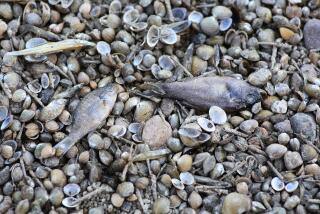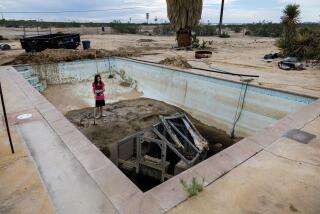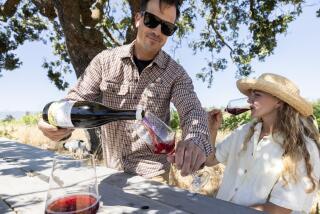Moving Water and Earth to Save a Farm
- Share via
MADERA, Calif. — For the first time since the San Joaquin River chewed through the old levee on its north bank and sent its surging flood waters his way, farmer Pete Andrew was ready to call it a day.
He had fought a maddening, 24-hour battle against a river that California agriculture had tamed for more than half a century. By Sunday morning, it had broken loose and swallowed the five miles of earthen dikes that Andrew, his son and elderly father and their 20-man crew had built through the rainy night, each breach drowning another perfect vineyard or orchard.
The young almond trees were crotch deep in river water. Ducks preened where raisins had dried. And yet seated in the cab of his Chevy pickup, Andrew, 49, still was marveling at how methodically the river had reclaimed a quarter of his 4,000-acre farm, while snapping photographs of his new “lakeside development” and finding comfort in the one dike that held. Water lapped its edges, sparing a half-million dollars’ worth of farm equipment inside a metal shed.
“I think the worst is over,” he said, bone-tired and heading for home. “If nothing else, we saved the whole shop complex.”
Then the phone rang. A voice crackled. The dike around the shop complex had broken. Water was gushing in. Andrew and his 23-year-old son, Matt, tore out the back door and down the orchard row, returning to a wild drama that had seen them save three lives from the raging water in one day, if not 1,000 acres of their farm.
Indeed, it was because the levee broke where it did that the farm towns of Mendota and Firebaugh were saved from major flooding. The Andrew ranch and tens of thousands of acres of surrounding cropland in Madera and Fresno Counties had served as a kind of buffer, absorbing the brunt of the river’s surge. A new lake, more than 12 miles long, now rests over the nation’s richest farm belt. Farmers said it would take several weeks to dry out and assess the damage.
“Our land served as a kind of sacrificial lamb,” said Pete Andrew’s 72-year-old father, George Andrew, the family patriarch. “If it’s got to be us or those poor people in Mendota and Firebaugh, I’d rather it be us.
“The grapevines should be fine. They’re hardy. But if it doesn’t dry out fast, we could lose a lot of almond trees.”
*
Before the San Joaquin River was dammed two dozen times in its upper reaches during the 1930s and ‘40s--98% of its flow diverted to agriculture--it was one of America’s mighty rivers. In winter months, much of this arid valley--which historically was a desert--was transformed into marsh and lake with steamships able to ply their way across it from San Francisco.
Today, this is a land of controlled irrigation, where virtually every drop of water behind Friant Dam above Fresno is calculated, priced and shunted via a maze of concrete and earthen canals. Water doesn’t go where man doesn’t intend it to go. The San Joaquin River is but a ghost. The leftover trickle that wends its way past a collection of golf courses and expensive houses in the river bottom is not much more than a public sewer, a drain for farming and municipal waste.
Then came a record 10 inches of rain--an entire year’s amount in only two months--followed by last week’s warm storm that melted much of the Sierra snowpack. In accordionlike fashion, one dam on the San Joaquin was forced to release to the next until it became Friant’s turn. In 1986, the last big flood, 17,000 cubic feet per second had to be released down the river channel on the valley floor. On Friday, more than 60,000 cubic feet came crashing down each second.
“My wife and I took a drive to Friant on Wednesday and I knew we were in trouble then,” Pete Andrew said.
He had heard stories about past historic floods from his father. But that was before Friant had been built. The river had always played a big part in the family lore since his father’s father, a sailor from Cyprus, arrived here in the early 1900s and married one of the old pioneering gold families, who had settled along the river’s banks. The family cemetery is in a pasture next to Friant.
“I’ve got a little Greek and a little Okie in me,” said Andrew, a big handsome man with thick salt-and-pepper hair. “Grandpa’s name was Parthanious Andronicou, but no one could pronounce it, much less write it. So he changed it to Pete Andrew.”
It was his father, George, who bought a small plot on the valley’s salty west side and began harvesting beans. He added to the farm acre by acre until he built it to its present size, 4,500 acres of table, raisin and wine grapes, almonds, cotton and wheat. It would qualify as large and corporate in many eyes, but the whole family works the land and there are no Mercedes parked in the driveway.
Neighbors say Pete, like his father, is a fastidious farmer who levels his own land with the use of a tripod and laser that can detect the slightest uneven slope in his fields.
The river runs five miles south of the ranch and Andrew figured he’d have plenty of warning before any waters came his way. But early Saturday, when one of the main levees broke, he learned something new about the river.
“It’s amazing how fast this water was moving. I fired up the heavy earth-moving equipment and called up our crew and we began building dikes and bagging sand and moving furniture out of the house, but as fast as we were moving, the river was moving faster. It was an incredible sight.”
He said he knew that his young almond orchard at the edge of the property was doomed, so he concentrated his forces on the land to the rear and on the equipment shed, which houses tractors and tanks and expensive tools. Part of the crew was working to build a moat around several expensive wells to prevent them from collapsing.
“We were trying to save as much as we could save, running big borders around the land and hoping to stem the flow. That’s when I saw this elderly Hispanic couple drive their car straight into the water.”
*
He climbed aboard a 10-ton earthmover and tried to make his way to their swamped car, which was fast filling up with water. Partway there, he was overcome with vertigo.
“I don’t know how I made it but I did. They had to be 75 years old and I told them in Spanish to get in the [earthmover’s] bucket. They crawled out the window with these funny looks on their faces and I drove them in the bucket over the other side, where it was dry.”
A few hours later, the night now dark and rainy and the lake across Avenue 7 in front of the ranch even deeper, a truck tried to make it across. This time, Andrew’s son, Matt, was sent to the rescue in a tractor. He ended up plucking out a cowboy in chaps, boots and stirrups with his three mutts, a .22 rifle, Bowie knife, saddle and guitar. “It was quite a scene to see this cowboy riding high on that John Deere [tractor]. The guy would have drowned, too.”
It was close to midnight. They had managed, heroics notwithstanding, to build a dike around the entire perimeter of the farm, five miles in all. Family and friends had come offering help, a place to stay, food--all the things you can count on in the country.
“I was exhausted, just plain exhausted. I went in and grabbed a plate of lasagna and went to bed,” Andrew said.
He awoke at daybreak, feeling good about the dike holding around the equipment shed, even if it had broken in all other spots. “You’ll be wishing you had this water come summer,” a neighbor farmer joked. “I’m 70% under myself.”
Before Friant, Hollywood stars like Clark Gable used to come here to hunt ducks. Once again, waterfowl were everywhere. Beavers were making new dams in alfalfa fields. Nature and agriculture had found a new balance, if only for a few weeks. Here was a lake as far as the eye could see, clear up to Avenue 14, seven miles away. Rubber drip irrigation lines were floating like strands of fettuccine. Andrew’s four huge earthmovers were mired in mud. It was a good lesson in humility, he realized.
“Truthfully, I don’t know what’s going to happen. I really don’t. These grapes can tolerate the water but these almonds, I don’t know. They are susceptible to root rot and they can die. It just depends on how fast the ground absorbs the water.”
He drove by the equipment shed shortly before noon. He told himself the water had crested; he thought he discerned an inch or two drop. “I’m feeling better about things. We may just make it. Wow, that’s how close we came to losing the whole shop complex--about one foot.”
It wasn’t 15 minutes later that the phone call came informing him of a big breach. He and Matt and two workers scooped frantically at the earth, trying to find dirt to close the gap but bringing up only mud. For more than an hour, tires submerged in water, they fought side by side until Andrew’s father got the idea to borrow a neighbor’s tractor equipped with a special blade. It closed the gap and saved the equipment shed.
“We held it,” he hollered triumphantly to the others. “We held it.”
Five hours later, as he wearily sat down to dinner, he again began to let himself believe that the worst was over. “It’s been a helluva two days, but I think we finally turned the corner,” he said. “I’m going to eat, check that dike one more time and then I’m going to bed.”
More to Read
Sign up for Essential California
The most important California stories and recommendations in your inbox every morning.
You may occasionally receive promotional content from the Los Angeles Times.










